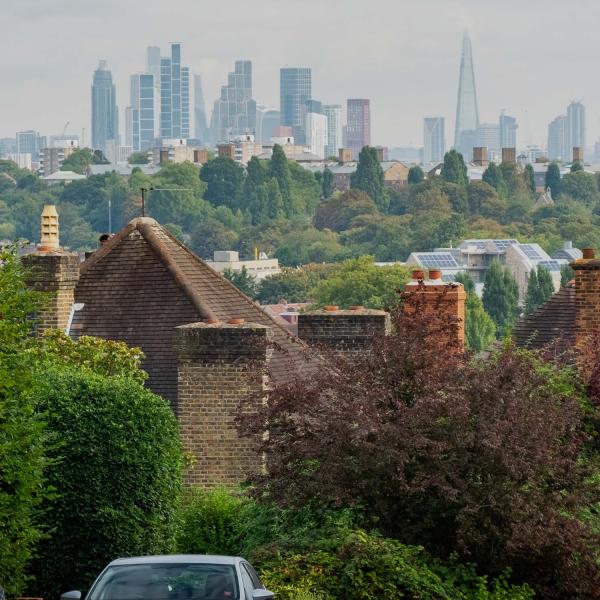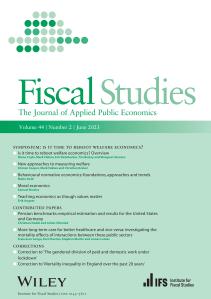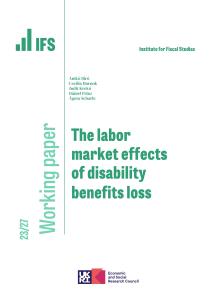Some of the numbers in the Table on the percentage of affected households in each region after the reform were corrected on the 14th November. The original table is at the bottom of the observation.
A lower cap on the total amount of benefits that households can receive comes into force tomorrow, affecting four times as many households as the previous benefit cap. Like the previous cap it will apply to out-of-work households of working age (with some exemptions, mainly due to disability). The cap will now be £23,000 a year in London and £20,000 elsewhere (there are lower caps for single adults without children set at £15,410 in London and £13,400 elsewhere). This compares to £26,000 nationwide under the previous cap, which has been in place since 2013. In this observation we look at the implications of a lower cap for government spending, the impact on the households affected, and how they might respond.
The previous cap
In 2015–16, the £26,000 cap directly reduced benefit spending by £65 million. 20,000 households are currently affected (as of this August), while 79,000 have been capped at some point since its introduction in Summer 2013. This cap almost exclusively affects families with large numbers of children or very high rents (who are receiving lots of housing benefit), or both: there is almost no other way to be getting so much in benefits. More than half have at least four children. Two-fifths live in London – where rents and Housing Benefit levels are high. Perhaps more surprisingly, half of those households currently affected rent from their local council or a housing association.
The cap does not apply to claimants of Working Tax Credit, providing a strong financial incentive for potentially affected families to do enough hours of paid work to qualify for it: 16 hours per week for lone parents and 24 for couples with children.
The direct effects of lowering the cap
The government’s impact assessment states that ignoring potential behavioural responses, the reduction in the cap will increase the number of families affected to 88,000, and will deliver an additional £100m a year of savings to the exchequer in the long run (with a slightly larger annual saving in the short run). This is less than 1% of the £12 billion of cuts to annual benefit spending planned by the current government during this parliament.
However, for those families who are affected, the impact can be large. Households who are already capped will lose a further £3,000 per year (in London) or £6,000 per year (elsewhere). The government expects those households newly affected by the cap to lose an average of £2,000 a year. In addition, unlike many of the cuts to benefits being implemented during this parliament, the lowering of the cap will result in affected families seeing cash drops in benefit income between one housing benefit payment and the next. This will feel different to real benefit levels falling as cash payments fail to keep pace with inflation, and changes that are being phased in by only applying to new claimants.
The reduction in the cap will also change the profile of the households affected. Most significantly, in large part because the cap will now be lower in the rest of the country than in London, those affected will be more evenly distributed geographically than was previously the case, as shown in Table 1. Under the old cap, 42% of affected households were in London. That figure is expected to fall to 22% under the new cap. The other side of that coin is that the policy will become significantly more important in many regions outside of London: in the North East for example, the number affected will rise from 600 to 4,000 households.
Table 1. Number of households affected by the benefit cap in each region and nation of Great Britain
Pre-reform | Post-reform | |||
Households | % | Households | % | |
North East | 600 | 3% | 4,000 | 4% |
North West | 1,400 | 7% | 9,000 | 10% |
Yorkshire and the Humber | 1,200 | 6% | 7,000 | 8% |
West Midlands | 1,700 | 9% | 10,000 | 11% |
East Midlands | 800 | 4% | 5,000 | 6% |
East | 1,400 | 7% | 8,000 | 9% |
London | 8,400 | 42% | 19,000 | 22% |
South East | 2,100 | 10% | 5,000 | 6% |
South West | 900 | 5% | 5,000 | 6% |
Wales | 600 | 3% | 4,000 | 5% |
Scotland | 800 | 4% | 5,000 | 6% |
Total | 20,000 | 100% | 88,000 | 100% |
Source: Pre-reform numbers – authors’ calculations based on August 2016 data from DWP Stat-Xplore. Post-reform numbers – Impact Assessment for the benefit cap
The reduction in the cap also means that its impact will be somewhat less concentrated on households with lots of children. Smaller households will no longer need to have extremely high housing benefit (HB) entitlements to be affected. Take, for example, an out-of-work couple with 2 young children renting in the private sector, where HB awards are themselves subject to caps which vary by local area. It was almost impossible for the previous benefit cap to affect them unless they lived in London, as the total of jobseeker’s allowance, tax credits, child benefit and the applicable HB cap in their area was less than the overall benefit cap everywhere outside of London. The same household could (if their rent is high enough) be affected by the new cap in more than half of local areas across England. For a lone parent with 2 young children the overall cap can now bind in a number of local areas outside of London, including Reading, Basingstoke and Bath – again it was almost impossible to be affected outside of London under the old cap.
Those examples illustrate a broader point. It is possible for the benefit cap to quickly affect many more out-of-work families in an area, once its level falls below the sum of the HB cap in that area for the family type in question and the other (nationally-set) benefit entitlements. Given the existence of these ‘tipping points’, further changes to the level of the cap could again have big effects not just on the number of households capped, but also on the types of households that are capped, in terms of number of children, geography and so on. This highlights one consequence of the approach of simply layering an overall cap on top of the benefits system, rather than addressing the underlying benefit rates (those for HB and child support) which cause the perceived problem: there is a risk of arbitrariness in its effects. It would be sensible for the government to set out a clear vision of which families it thinks receive excessive amounts of benefits and why.
How might people respond?
As discussed in a previous observation, we have fairly robust evidence that about 5% of those affected by the previous cap responded to that cap by moving into work. An even smaller fraction – and only those who lost particularly large amounts of income – moved house in response.
Hence it would be reasonable to expect the further lowering of the cap to result in some increases in employment as people respond to the strengthened financial incentive to be in paid work, and in some of those affected moving to a cheaper home. Another possible response is for households to claim disability benefits in order to become exempt from the cap. Of the 79,000 households who have been capped since its introduction in Summer 2013, 12,000 became exempt due to a disability benefit claim (we do not know how many of those 12,000 would have started a disability claim if the cap did not exist, so this does not reveal the effect of the policy).
However, all this suggests that the majority of those affected will not respond by moving into work, moving house or claiming a disability benefit. For that majority it is an open question how they will adjust to the loss of income. One mitigating factor that is likely to be significant is Discretionary Housing Payments (DHPs): money paid at the discretion of local authorities to help tenants deemed to be struggling to pay their rent. In 2015–16, £25 million of DHPs were allocated specifically to help tenants affected by the benefit cap (offsetting almost 40% of the direct £65 million saving from the cap). About 40% of those affected by the benefits cap so far have successfully applied for DHPs. These DHPs look likely to play a key role in mitigating the impact of the cuts on some of the families affected - whilst rendering the net fiscal savings from the cap all the more trivial.
--
Original Table 1.
| Households | % | Households | % |
North East | 600 | 3% | 4,000 | 4% |
North West | 1,400 | 7% | 9,000 | 10% |
Yorkshire and the Humber | 1,200 | 6% | 7,000 | 8% |
West Midlands | 1,700 | 9% | 10,000 | 6% |
East Midlands | 800 | 4% | 5,000 | 11% |
East | 1,400 | 7% | 8,000 | 9% |
London | 8,400 | 42% | 19,000 | 22% |
South East | 2,100 | 10% | 11,000 | 13% |
South West | 900 | 5% | 5,000 | 6% |
Wales | 600 | 3% | 4,000 | 6% |
Scotland | 800 | 4% | 5,000 | 5% |
Total | 20,000 | 100% | 88,000 | 100% |









